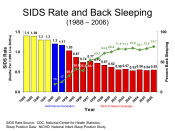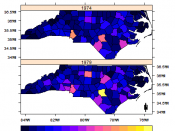Imagine the thought of a mother going in to her child's room and kissing her baby good night, expecting to hear the gentle breath of her baby. Instead all that she hears is silence. Sudden Infant Death Syndrome (SIDS) is the "sudden death of an infant under one year of age which remains unexplained after a thorough case investigation, including performance of a complete autopsy, examination of the death scene, and review of the clinical history" (Willinger, 1991).
More children die of SIDS in a year than all who die of cancer, heart disease, pneumonia, child abuse, AIDS, cystic fibrosis and muscular dystrophy combined. Many researchers now believe that babies who die of SIDS are born with one or more conditions that make them especially vulnerable to stresses that occur in the normal life of an infant, including both internal and external influences.
SIDS is unexpected, usually occurring in otherwise apparently healthy infants from 1 month to 1 year of age.
Most deaths from SIDS occur by the end of the sixth month, with the greatest number taking place between 2 and 4 months of age.
A SIDS death occurs quickly and is often associated with sleep, with no signs of suffering. More deaths are reported in the fall and winter and there is a 60-to-40-percent male-to-female ratio. A death is diagnosed as SIDS only after all other alternatives have been eliminated: SIDS is a diagnosis of exclusion (Willinger, 1991).
Risk factors are those environmental and behavioral influences that can provoke ill health. Any risk factor may be a clue to finding the cause of a disease, but risk factors in and of themselves are not causes. Researchers now know that the mother's health and behavior during her pregnancy and the baby's health before birth seem to influence the occurrence...



SIDS
This appears to be a well written and researched essay on an emotive issue.
Just for your information, there is a theory regarding mattress wrapping which has been adopted by the New Zealand government following extensive research by Dr Jim Sprott (PhD in chemistry).
He acknowledges the importance of many of the current SIDS guidelines but believes there is a link between toxic gases in mattresses and SIDS.
There has never been a SIDS incident where parents have used this method. If anyone is interested in this issue, the official website is www.cotlife200.co.nz.
5 out of 5 people found this comment useful.